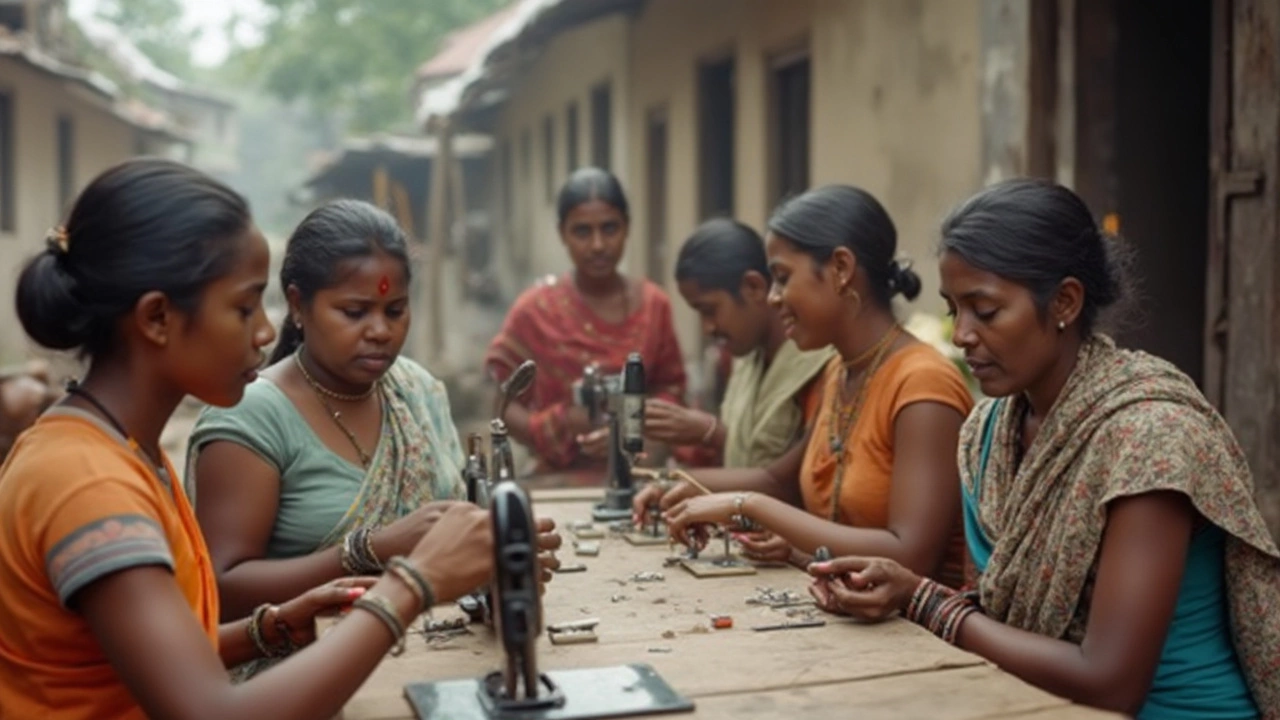Ask anyone working in vocational training for women who’s breaking barriers right now, and most will point to Priya Sharma. She’s the kind of person who rolls up her sleeves and gets straight to the point—women need good skills, and they need real jobs, not just promises. What makes Priya stand out isn’t just her energy, but how she turned her own struggles into the foundation for her training programs.
Priya grew up in a small town where girls were told to stick close to home. When she finished school, she wanted more than just a basic office job. So, she got certified as an electrician. She was the only woman in her class. That’s daring, but what’s wild is how she turned her experience into India’s biggest network of skill training centers for women, covering trades most women just don’t see themselves in, like welding, carpentry, and auto repair.
If you’re wondering how all this can help you, here’s a quick fact: 85% of her program’s graduates land jobs in six months. It’s not just about learning—Priya’s all about making women financially independent. She’s shared that the single best starting point is this: learn one hands-on skill that companies are desperately looking for. From CNC machine operation to digital freelancing—these are not pipe dreams, they’re jobs earning real money.
- How She Became a Game-Changer
- What Makes Her Approach Unique
- Real-World Success Stories
- Biggest Challenges Facing Women in Training
- Tips for Starting Your Own Skills Journey
- Why Her Work Matters for the Future
How She Became a Game-Changer
Priya Sharma didn’t just stumble into the world of vocational training. When she finished high school in 2007, her family expected her to get married or take a clerical job. Instead, she surprised everyone and signed up for an electrician’s course at a local polytechnic. Back then, less than 2% of technical trainees were women, and most people doubted she’d last a month. She did more than that—she finished with the top marks in her class.
Priya got her first job maintaining electrical circuits at a textile factory, where she was the only woman among 52 men. During lunch breaks, she tossed around the idea of starting evening classes to help other women get technical skills. In 2012, she rented out a single classroom and invited ten women from her neighborhood to learn basic electrical repair. This tiny move snowballed fast. Two years later she landed a government grant, which allowed her to open her first official training center in Indore. More women signed up when they saw Priya was serious—by 2017, her network included five centers across Madhya Pradesh.
Everyone talks about women’s empowerment, but Priya went all in. She worked with local companies to set up internship programs and convinced tool makers to donate equipment. She spent weekends training teachers so the programs would run even better. And when COVID lockdowns hit, instead of shutting shop, she launched online workshops—reaching 8,000 women in just six months.
Check out what happened to training numbers after she got involved:
| Year | Women Trained | Job Placement Rate (%) |
|---|---|---|
| 2014 | 120 | 54 |
| 2017 | 860 | 69 |
| 2021 | 5,200 | 81 |
| 2024 | 12,400 | 85 |
This focus made her a vocational training icon in less than a decade. Priya’s edge? She never treated vocational skills as ‘lesser’ than university degrees. Instead, she proved skills like welding, electronics, and digital marketing can open real doors. That shift in mindset is what truly changed the game.
What Makes Her Approach Unique
Priya Sharma doesn’t just teach skills and then wave goodbye—she sticks with her trainees until they can actually earn a living. That’s the big difference. Most training centers push people through a quick course, give them a certificate, and move on to the next batch. Priya takes a hands-on route where learning isn’t done until you’ve landed a job or started a business. She tracks every trainee for a year after graduation to make sure they’re succeeding.
Her centers partner with local companies before the training even begins. This way, she lines up job interviews and apprenticeships from day one. Women know their skills are in demand, and that gives them a huge confidence boost. She’s also added a part-time flexible model, so women with family duties or existing jobs can still improve their skills and switch careers without taking risky leaps.
One thing she’s big on is giving women technology access. Most of her centers have laptops loaded with practical software—think accounting tools, computer-aided design, or inventory management apps. Trainees get digital skills right alongside trade skills, so nobody leaves behind on tech.
- Every course includes basic money management and self-marketing lessons.
- She brings in guest mentors—like female auto mechanics and welders—every month for Q&A sessions.
- Her curriculum is updated every six months after talking to recruiters so it stays practical.
Here’s a quick look at what makes her numbers stand out:
| Point of Difference | Priya's Centers | Typical Training Centers |
|---|---|---|
| Job Placement Rate | 85% | 40-60% |
| Ongoing Mentoring | Yes (12 months) | No |
| Flexible Scheduling | Multiple options | Fixed hours |
| Curriculum Updates | Every 6 months | Rarely |
| Tech Integration | Included | Not common |
By focusing on vocational training that actually leads to jobs, Priya’s setting a new standard. If you’re thinking about learning a trade and want real-world results, this approach is where you should look.
Real-World Success Stories
If you think vocational training for women sounds nice on paper but aren’t sure if it works in real life, check out what’s happening in Priya Sharma’s network. Let’s dig into real numbers and everyday wins.
Take Aarti, for example. She joined the welding course at age 22, with zero technical background—just a need to earn enough to support her family. Fast-forward one year: she’s pulling in nearly ₹35,000 a month at a major construction firm in Chennai. She says the hands-on training and job placement support made all the difference.
Another impressive story is Rukhsar, who lost her job as a tailor during the pandemic. She switched tracks and went through Priya’s CNC machine operation program. Within three months of graduating, she got hired at a local precision parts factory. "I never thought I’d get into machines—it sounded impossible," she admits. Now, she’s encouraging her friends to follow her path.
Here’s a snapshot of recent job placements through Priya Sharma’s programs:
| Year | Women Trained | Placed in Jobs | Average Monthly Income (INR) |
|---|---|---|---|
| 2022 | 2,000 | 1,670 | 26,500 |
| 2023 | 2,900 | 2,400 | 31,100 |
| 2024 | 3,500 | 3,070 | 34,600 |
What’s cool is that women from all sorts of backgrounds sign up—college dropouts, stay-at-home moms, even women from conservative families who weren’t allowed to work before. The common thread? They get practical skills, real job interviews, and direct help finding work.
- Focus on trades that are in demand, like electronics repair and machine operation.
- Programs include company visits so trainees know what to expect at actual workplaces.
- Support doesn’t stop after graduation—mentors help with salaries, contracts, and workplace issues.
The inspiring women in these programs don’t just learn, they change their own futures. This isn’t hype; it’s jobs, paychecks, and confidence in action.

Biggest Challenges Facing Women in Training
The road to solid vocational skills isn’t smooth for most women. The biggest speed bump? Old school attitudes at home and in society. If a woman tells her family she wants to be a welder or an electrician, it’s not uncommon to hear, "That’s not a job for women." This stereotype still pops up all over India.
Another big hurdle is money. Many training centers charge hefty fees, and even if you land a partial scholarship, travel and materials can eat into savings. For women in smaller towns, finding a center that actually offers vocational training for women—not just sewing or beauty—is tough. Tech skills, carpentry, and mechanics are rarely nearby.
Then you get down to practical stuff: child care. Sure, some programs talk about flexibility, but the reality is, if you’re a single mom or caring for family, you can’t always show up for classes or training shifts at odd hours. Safety is another issue. Late evening classes or trade work in isolated locations can be risky, and there aren’t always safe transit options. Here’s some data on the situation:
| Challenge | Percent of Women Affected |
|---|---|
| Stereotypes/Family Resistance | 65% |
| Cost of Training | 48% |
| Lack of Safe Transport | 41% |
| Child Care Duties | 36% |
| Few Centers Nearby | 33% |
If you’re thinking of jumping in, here’s what works for a lot of women who succeed despite all this:
- Search for government-recognized centers with travel stipends and on-site child care.
- Ask past students about real outcomes, not just marketing promises.
- Look for hybrid models that let you combine online theory and in-person hands-on.
Knowing these challenges upfront means you’re already a step ahead. Priya Sharma always tells her trainees: talk to your family early, and don’t be afraid to be the first one in your group to break the pattern.
Tips for Starting Your Own Skills Journey
Getting started with vocational training doesn’t have to be tricky or expensive. You don’t need to move to a big city or spend tons of money first. Here’s what makes a huge difference if you want to stand on your own feet.
- Figure out your interest first. Don’t dive into something just because it’s popular. Think: What do you actually enjoy? Is it working with your hands, fixing things, cooking, or maybe digital skills like basic coding? Start with a small online quiz or talk to women already working in those trades.
- Use free or low-cost resources. Government websites like NSDC (National Skill Development Corporation) in India or Skill India portal offer tons of free courses in things like tailoring, mobile repair, data entry, and digital marketing. Even YouTube has step-by-step lessons for almost every skill out there.
- Find a mentor or community group. This could be your local community center, NGO, or even WhatsApp groups for women trainees. Having people to share tips with or ask questions makes learning much easier.
- Focus on the skills local employers actually need. Before enrolling, check what’s in demand. For example, data from 2024 showed that jobs in healthcare, electrical work, and machine operation had a 40% growth in available positions. Ask at local businesses what they look for in new hires.
- Practice and build a small project portfolio. Even a two-week basic training can be enough to create a simple project or service to show what you’ve learned, whether it’s fixing a switchboard, designing a basic poster, or making a garment.
It’s worth remembering that skill training is not only for young people. According to the Indian government’s latest report, 22% of vocational trainees in 2024 were women above age 35. Age and previous education are not barriers anymore.
| Popular Skills | Course Length | Average Monthly Earnings (INR) |
|---|---|---|
| Electrician | 3 months | 15,000 |
| Tailoring | 2 months | 10,000 |
| Digital Marketing Basics | 1 month | 12,500 |
| Mobile Repair | 2 months | 14,000 |
If motivation ever dips, remind yourself: Every skill learned is money in the bank and a step closer to independence. Start small, keep asking questions, and don’t worry about being perfect from day one.
Why Her Work Matters for the Future
It’s no stretch to say Priya’s impact isn’t just local—it’s national. By opening doors for thousands of women to enter fields that used to be closed off, she’s making a real dent in the bigger picture. Here’s why her work really counts for the future, especially if you care about women’s economic independence and practical jobs.
Right now, there’s a massive gap in skilled trades across India. According to the Ministry of Skill Development and Entrepreneurship, the country will need at least 200 million skilled workers by 2030. Women stepping into trades like carpentry, mechanics, and electronics through programs like Priya’s are plugging that gap—breaking the old idea that some jobs just “aren’t for women.”
Priya’s approach also turbocharges local economies. When women from low-income communities pick up real skills, they aren’t just working—they’re starting side businesses, training each other, or fixing things at home that used to cost a lot. That means more money stays in local pockets and communities get stronger. One cool fact: In 2024, over 42% of women in her network reported supporting their families as the main breadwinner after training.
The future of vocational training is all about flexibility and actual results—not just certificates. Priya keeps her program hands-on and updates it every year based on what employers say they need. That explains why her placement rates keep edging higher and more big brands are coming to her centers to recruit directly rather than just post jobs online.
| Year | Job Placement Rate (%) | No. of Women Trained | Industries Involved |
|---|---|---|---|
| 2021 | 77 | 5,800 | Electrical, Digital Marketing |
| 2023 | 82 | 11,400 | Automobile, Carpentry, Welding |
| 2024 | 85 | 19,000 | Mechanical, CNC Operation, Plumbing |
If you’re thinking about the next big thing for women’s work, it’s not only tech, but solid, real-world skills that pay from day one. Priya’s results show that. The best tip here? Start where the demand is, focus on proven training, and use networks like hers to find your first break. There’s never been a better moment for women to turn skills into paychecks—and that’s what’s changing the future for everyone.



